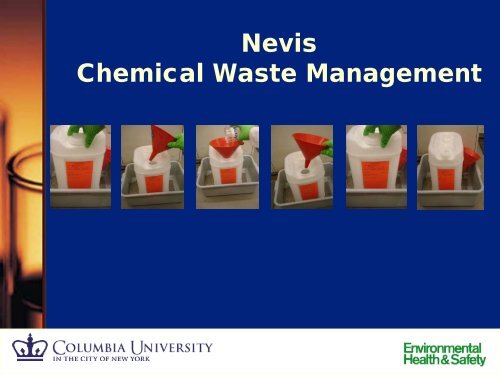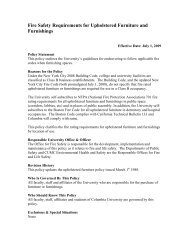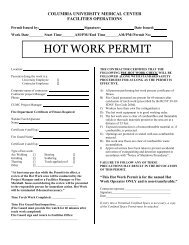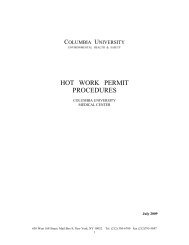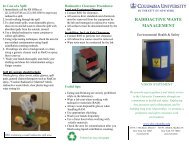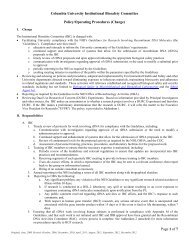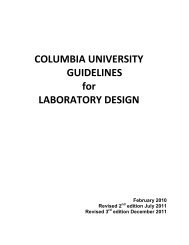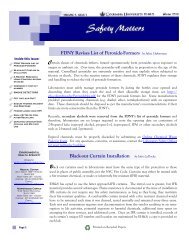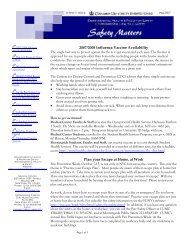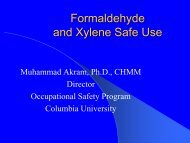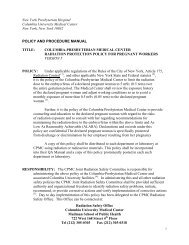Chemical/Hazardous Waste Management (Nevis) - Environmental ...
Chemical/Hazardous Waste Management (Nevis) - Environmental ...
Chemical/Hazardous Waste Management (Nevis) - Environmental ...
Create successful ePaper yourself
Turn your PDF publications into a flip-book with our unique Google optimized e-Paper software.
<strong>Nevis</strong><br />
<strong>Chemical</strong> <strong>Waste</strong> <strong>Management</strong><br />
1
Agenda<br />
• Laboratory Safety<br />
• <strong>Waste</strong> Minimization<br />
• Laboratory Container and Glassware <strong>Management</strong><br />
• <strong>Hazardous</strong> <strong>Waste</strong><br />
– Rules and Regulations<br />
– Identification of <strong>Hazardous</strong> <strong>Waste</strong><br />
– Proper Collection and <strong>Management</strong> of <strong>Hazardous</strong><br />
<strong>Waste</strong><br />
• Examples<br />
– Lab Equipment Disposal<br />
– <strong>Hazardous</strong> <strong>Waste</strong> review<br />
2
EMS Policy and Procedure<br />
The EMS’s No Drain Disposal Policy requires<br />
all waste to be collected for safe and proper<br />
disposal through EH&S.<br />
3
EMS: Green Initiatives &<br />
waste minimization tips<br />
• Battery collection program<br />
• <strong>Chemical</strong> recycling: acetone,<br />
alcohol and xylene recovery<br />
• Do not mix different waste<br />
types<br />
• Consider micro scale<br />
experiments<br />
• Consult EH&S for project<br />
planning<br />
• Reusable sharps containers<br />
• Glassware recycling<br />
• Plan 2017: 30% reduction in<br />
energy use<br />
4
<strong>Hazardous</strong> <strong>Waste</strong> is Regulated<br />
at the Federal and State Level<br />
5
<strong>Hazardous</strong> <strong>Waste</strong> Responsibilities<br />
<strong>Hazardous</strong> <strong>Waste</strong> is managed in accordance with a<br />
“cradle to grave” approach.<br />
6
Resource Conservation and<br />
Recovery Act (RCRA)<br />
• RCRA defines and establishes proper management<br />
standards for <strong>Hazardous</strong> <strong>Waste</strong>s.<br />
• The following categories provide the basis for identifying<br />
<strong>Hazardous</strong> <strong>Waste</strong>s:<br />
– Characteristic <strong>Hazardous</strong> <strong>Waste</strong><br />
– Listed <strong>Hazardous</strong> <strong>Waste</strong><br />
– Inherently waste-like materials<br />
– Mixed <strong>Waste</strong><br />
– Universal <strong>Waste</strong>s<br />
7
Characteristic <strong>Hazardous</strong><br />
<strong>Waste</strong>: Ignitability<br />
Substances that are oxidizers or with a flashpoint less than<br />
140° Fahrenheit<br />
• Ethanol<br />
• Spray paint<br />
• Paraformaldehyde<br />
• Activated carbon<br />
• Sodium perchlorate<br />
8
Characteristic <strong>Hazardous</strong><br />
<strong>Waste</strong>: Corrosivity<br />
Substances with a pH less than or equal to 2<br />
or greater than or equal to 12.5<br />
• Hydrochloric acid<br />
• Sodium hydroxide solution<br />
9
Characteristic <strong>Hazardous</strong><br />
<strong>Waste</strong>: Reactivity<br />
Substances that react violently with water or generate<br />
toxic gases, vapors, or fumes when mixed with water; or<br />
are normally unstable or capable of detonation<br />
• Sodium metal<br />
• Dry picric acid<br />
• Potassium cyanide<br />
10
Characteristic <strong>Hazardous</strong><br />
<strong>Waste</strong>: Toxicity<br />
Substances capable of causing death or injury<br />
in an organism due to a physicochemical<br />
reaction<br />
• Arsenic<br />
• Cadmium<br />
• Chloroform<br />
• 1,4-Dichlorobenzene<br />
• Lead<br />
• Mercury<br />
• Methyl ethyl ketone<br />
• Silver<br />
11
Listed <strong>Hazardous</strong> <strong>Waste</strong><br />
• Specific, acutely toxic chemicals<br />
appearing on the USEPA and NYSDEC<br />
lists are P-listed <strong>Hazardous</strong> <strong>Waste</strong>s.<br />
– Allyl alcohol<br />
– Epinephrine<br />
– Sodium azide<br />
P-List<br />
12
Inherently <strong>Waste</strong>-like <strong>Chemical</strong>s<br />
<strong>Chemical</strong>s can become “inherently<br />
waste-like” and must be handled as<br />
<strong>Hazardous</strong> <strong>Waste</strong>, if they have:<br />
• Expired shelf-life<br />
• No foreseeable use<br />
• Contaminated or unusable<br />
chemicals<br />
• Significant deterioration of label<br />
and/or container<br />
13
What are the Four Hazards<br />
Associated with Characteristic<br />
<strong>Hazardous</strong> <strong>Waste</strong><br />
Reactive<br />
Flammable<br />
Toxic<br />
Corrosive<br />
14
Mixed <strong>Waste</strong><br />
Mixed <strong>Waste</strong> includes a RCRA<br />
<strong>Hazardous</strong> <strong>Waste</strong> and a radioactive<br />
isotope. Some common examples of<br />
laboratory Mixed <strong>Waste</strong> include:<br />
• Phenol-chloroform mixtures used in<br />
extractions of radiolabelled nucleic<br />
acids.<br />
• Certain gel electrophoresis waste<br />
(e.g., methanol or acetic acid<br />
containing radionuclides).<br />
• HPLC waste containing acetonitrile<br />
and a radionuclide.<br />
• Contact a Radiation Safety Officer<br />
(RSO) for guidance if your lab<br />
generates Mixed <strong>Waste</strong>.<br />
15
Universal <strong>Waste</strong><br />
Universal <strong>Waste</strong> includes a variety of common items<br />
that contain RCRA <strong>Hazardous</strong> <strong>Waste</strong>s, which also must<br />
be managed to prevent environmental contamination.<br />
– UV and fluorescent lamps<br />
– Batteries<br />
– Mercury devices<br />
16
Used Batteries<br />
• CU collects and recycles<br />
over 40 tons (36,287 kgs) of<br />
used batteries from all<br />
locations.<br />
• Batteries are not permitted to<br />
be thrown in the trash.<br />
• Battery terminals should be<br />
covered with non-conductive<br />
tape or individually bagged<br />
and disposed of in a Used<br />
Battery Collection Container.<br />
• <strong>Nevis</strong> locations: RARAF<br />
entrance and Cyclotron<br />
building near water cooler.<br />
17
Used Oil <strong>Management</strong><br />
• Used oil is collected<br />
and recycled through<br />
EH&S.<br />
• All collected material<br />
must be kept in a<br />
closed container and<br />
labeled as “Used<br />
Oil”.<br />
18
Five Rules of <strong>Hazardous</strong><br />
<strong>Waste</strong> <strong>Management</strong><br />
The Five Ls are a quick reference to<br />
assist in managing <strong>Hazardous</strong> <strong>Waste</strong>:<br />
• coLLect<br />
• Label<br />
• Lid<br />
• Locate<br />
• Leaks<br />
19
<strong>Hazardous</strong> <strong>Waste</strong> <strong>Management</strong><br />
The First of the Five Ls<br />
• coLLect<br />
– Anything flammable, corrosive,<br />
reactive, or toxic must be<br />
coLLected as <strong>Hazardous</strong> <strong>Waste</strong>.<br />
– Even small amounts (i.e. a few mL) must be<br />
coLLected.<br />
– The coLLection container must be compatible (won’t<br />
react) with the <strong>Hazardous</strong> <strong>Waste</strong>.<br />
• Do not coLLect hydrofluoric acid in glass<br />
containers.<br />
• Do not coLLect corrosive materials in metal<br />
containers.<br />
20
<strong>Hazardous</strong> <strong>Waste</strong> <strong>Management</strong><br />
The Second of the Five Ls<br />
• Label<br />
– Label a container when<br />
the first drop of<br />
<strong>Hazardous</strong> <strong>Waste</strong> is<br />
added.<br />
– All components of the<br />
<strong>Hazardous</strong> <strong>Waste</strong> must<br />
be listed.<br />
– Do not use short hands,<br />
abbreviations or generic<br />
names (e.g. “organics”<br />
or “halogenated”).<br />
21
<strong>Hazardous</strong> <strong>Waste</strong> Labels<br />
(continued)<br />
Proper labeling requires the<br />
full chemical name; no<br />
abbreviations or formulas.<br />
• EtOH ≠ Ethanol<br />
• HNO 3 ≠ Nitric Acid<br />
• HCOH ≠ Formaldehyde<br />
• CH 2 Cl 2 ≠ Methylene Chloride<br />
22
<strong>Hazardous</strong> <strong>Waste</strong> <strong>Management</strong><br />
The Third of the Five Ls<br />
• Lid<br />
– <strong>Hazardous</strong> <strong>Waste</strong> collection<br />
containers must be closed at<br />
all times, except during the<br />
active filling of the container.<br />
– The Lid of the container must<br />
be screwed on tightly.<br />
– An open funnel or tubing<br />
must not be left in the top of<br />
the container.<br />
– If the container were to be<br />
knocked over, no waste<br />
should be spilled. For this<br />
reason, Parafilm is not an<br />
acceptable closure.<br />
23
<strong>Hazardous</strong> <strong>Waste</strong> <strong>Management</strong><br />
The Fourth of the Five Ls<br />
• Location<br />
– <strong>Hazardous</strong> <strong>Waste</strong> must be collected<br />
“at or near” the point of generation (a.k.a.<br />
Satellite Accumulation Area).<br />
– <strong>Hazardous</strong> <strong>Waste</strong> cannot be moved to a<br />
collection area in another room at any other<br />
campus besides <strong>Nevis</strong>.<br />
24
<strong>Hazardous</strong> <strong>Waste</strong> <strong>Management</strong><br />
The Fifth of the Five Ls<br />
• Leaks<br />
– <strong>Hazardous</strong> <strong>Waste</strong> collection containers<br />
must be visually inspected by the generator<br />
of the waste on a regular basis to check for<br />
Leaks.<br />
– Contact EH&S at ext. 212-854-8749 for<br />
assistance.<br />
25
<strong>Hazardous</strong> <strong>Waste</strong> <strong>Management</strong><br />
Proper Collection and <strong>Management</strong> of <strong>Hazardous</strong><br />
<strong>Waste</strong> does not allow for the following:<br />
• Evaporation<br />
• Neutralization<br />
• Dilution<br />
• Treatment<br />
26
For <strong>Hazardous</strong> <strong>Waste</strong> Pickup<br />
http://vesta.cumc.columbia.edu/ehs/wastepickup/<br />
27
Examples<br />
http://ehs.columbia.edu/<br />
28
Acceptable: <strong>Waste</strong><br />
<strong>Management</strong><br />
29
Unacceptable: CoLLection<br />
30
Unacceptable: Labels<br />
31
Unacceptable: Lids<br />
32
Unacceptable: Location<br />
33
Unacceptable: Leaks<br />
34
Unacceptable: Inherently <strong>Waste</strong>-like<br />
35
Lab Equipment Disposal<br />
– If used with radioactive<br />
material, FIRST a radiation<br />
safety officer must perform a<br />
wipe test and also clear the<br />
item.<br />
– If used with any biological<br />
materials, the item must be<br />
decontaminated with 10%<br />
bleach or 70% ethanol.<br />
– If any chemical contact was<br />
possible, item must be<br />
decontaminated with soap or<br />
mild detergent.<br />
– Refrigerants and/or oils must<br />
be removed before disposal,<br />
if applicable.<br />
36
Medical Center Campus<br />
Disposal of Empty Laboratory <strong>Chemical</strong> Containers and<br />
Glassware<br />
37
In what Containers should<br />
these <strong>Waste</strong>s be Collected<br />
38
What is Wrong with this Label<br />
• Generator name,<br />
location and contact<br />
information must be<br />
listed.<br />
• Hg must be listed as<br />
Mercury.<br />
• Solvents must be listed<br />
with their full proper<br />
names.<br />
• Concentrations must<br />
be listed for each<br />
component.<br />
39
How should Oil waste be<br />
Managed<br />
• Used oil must be<br />
kept in a closed<br />
container and<br />
marked or labeled<br />
as “USED OIL”.<br />
• Oil must not be<br />
labeled as<br />
“<strong>Hazardous</strong><br />
<strong>Waste</strong>” or “<strong>Waste</strong><br />
Oil”.<br />
40
•To receive credit for this training, you must<br />
initialize yourself on the RASCAL system at<br />
https://www.rascal.columbia.edu/ by signing<br />
in with your UNI within 24 hours of<br />
completing the training.<br />
•Copies of today’s training slides can be<br />
found at<br />
http://www.ehs.columbia.edu/TrainingContent<br />
s.html<br />
•We appreciate your feedback. Any questions<br />
or suggestions can be submitted on our<br />
electronic evaluation found at<br />
http://www.ehs.columbia.edu/TrainingContent<br />
s.html<br />
41
Any Questions<br />
Please return your completed evaluations and make sure<br />
you neatly enter your information on the sign in sheet.<br />
42
Please click the<br />
link and fill out<br />
evaluation sheet.<br />
Start Evaluation<br />
43


